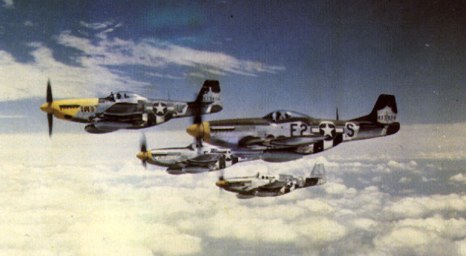North American P-51 Mustang
United States | Bell P-39 | Bell P-59 | Bell P-63 | Brewster F2A | P-36 Hawk | P-40 Warhawk | F4F Wildcat | F6F Hellcat | F7F Tigercat | F8F Bearcat | P-38 Lightning | Lockheed P-80 | P-51 Mustang | P-61 Black Widow | P-47 Thunderbolt | F4U Corsair
P-51 Mustang
The P-51 Mustang was, with little argument, the single greatest fighter of World War 2. Its career began when the British Air Purchasing Commission requested the North American compaly to build them a fighter. At first, a Curtiss design was considered to be built under contract by North American, but they decided to build an entirely new fighter instead. The result was the P-51 Mustang, known to the British as the A-36. It was designed, built, and flown in only 117 days, the unpainted prototype to be the start of the most successfil fighter program in all of aviation history. It flew on October 26th 1940.
Exceedingly pleased with the fighter, the British ordered hundreds of the machines and this atracted American attention. At once it was realized that this fighter built by North American was a superb aircraft, and it would be a serious error not to put it into service right away for American squadrons. As the first P-51s reached Britain in November of 1941, the US was just getting interested in them, and unfortunately were too occupied with the P-38 and P-47 to worry about the P-51 all that much. It would be years later until the P-51 would fight under the American star.
The sleek, low winged Mustang was among the very first to use a laminar-flow wing, which resulted in far less drag. Also, the P-51 had its wingtips, rudder, and elevators with square-cut ends, unlike almost every other aircraft at the time. It paid off, as the P-51 could reach 380mph while the lighter Spitfire, with half as much fuel weight, could not get within 15mph of that figure.
The P-51 first saw action in June of 1942, and covered the unsuccessful landing at Dieppe. It was the Allison engine that was blamed for the fighters early performance, for it lost power considerably at high altitudes. A major step in the development of the P-51 was the addition of the Rolls Royce Merlin engine. Four P-51s were given Merlins, and their poerformance was so good that North American began designs to build all P-51s with a Merlin engine, lisense built in the US as the Packard V-1650-3.
America ordered 500 of the Allison fighters, intending to use them as ground attack aircraft, and they were even complete with airbrakes. The airbrakes caused so much trouble that eventually they were cut of their control wires and left inoperative. The P-51 Mustang was never suited much for the role of ground attack. As with the British, the Allison engine was unsuited for high altitde use and performance was poor. At last, 2,200 P-51Bs with the Packard Merlin as its powerplant were ordered by the US, and the period as the P-51 as a major fighter began.
When the Americans began high altitude daylight bombing raids on Axis positions, the P-51 was there to escort them. At first they could only escort the bombers part of the way, but added drop tanks enabled them to be with the bombers for the entire mission. It is probably in this role that the P-51 earned its respect it has come to deserve.
In combat, the P-51 proved superior to the Bf 109s, and even the modern Fw190 was hard pressed to match a P-51, in either maneuverability or firepower. Several P-51s, though not that many, fought the brand new German jet fighter the Me 262, and a few even shot them down. The P-51s fought well out of WW2 and into Korea, where they were used as both attack and fighter aircraft. With ease the Russian Yakovlev fighters were shot down by the Mustang, and once even a MiG-15 was hit and probably eventually shot down by a pair of P-51Ds.
--B.G.

More Information
Remarks
Model NA-73; Developed for UK
Prod. model; 4 20mm cannon
Fitted w/ bomb racks; 4 .50-cal. mgs
Imp. P-51; was XP-78
Prod. model; Blks 1-15; Inglewood
Dallas Plant; Blks 1-11
Bubble Canopy; Blks 1-30
Blks 5-30; 6 .50-cal. mgs.
2-place trainer variant
Model not assigned
Exp. lt. weight test model
Mod. XP-51F w/ new eng.
Prod. model; Blks 1-10
Mod. XP-51F w/ new eng.
Imp. -D; Aeroprop; Blks 1-15
Imp. -H w/ new eng.
Imp. -H w/ new eng.
SPECIFICATIONS P-51D
Span: 37 ft. 0 in.
Length: 32 ft. 3 in.
Height: 13 ft. 8 in.
Weight: 12,100 lbs. max.
Armament: Six .50-cal. machine guns and ten 5 in. rockets or 2,000 lbs. of bombs.
Engine: Packard built Rolls-Royce "Merlin" V-1650 of 1,695 hp.
Cost: $54,000
PERFORMANCE
Maximum speed: 437 mph.
Cruising speed: 275 mph.
Range: 1,000 miles
Service Ceiling: 41,900 ft.
This aircraft information is from the USAF Museum Archives.